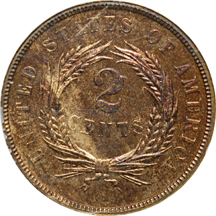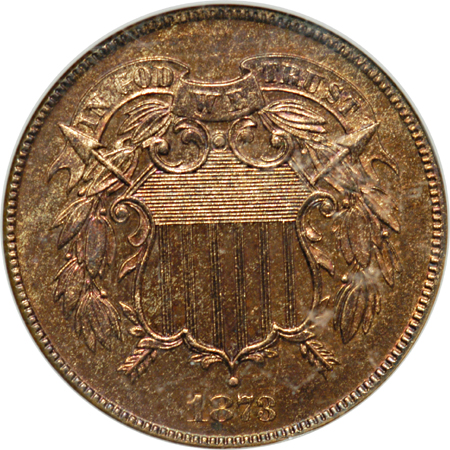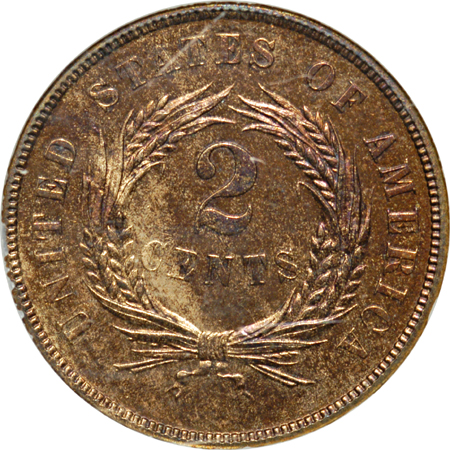The Collectors' Auction 2007
< Previous
Lot
308
Next >
| Choose Category: |
|
|
|
|
|
|
|
Please Note: A 15% Buyers' Premium is added to the hammer price of all lots in this sale.
|
(About The Images)


|
|
Lot Title:
|
1873 Closed 3. NGC PF-65 RB.
|
|
Description:
|
In this age of the automobile and inexpensive air travel, the modern American does not often appreciate the extraordinary influence that the railroad industry had on the nationwide economy in the years following the Civil War. From the end of the war through 1873, 35,000 miles of track was laid, enough to stretch across the United States more than ten times, and thus, the industry was the nation's second largest employer (behind agriculture).
Railroad transportation was modern, current technology in the 1870s, albeit a labor-intensive industry. The cost of laying down railroad track was enormous and required large amounts of money to pay for land, expensive manual labor, and material; that meant large amounts of risk. But the potential reward was also very great, and a huge influx of cash from speculators spurred abnormal growth in the industry through much of the later nineteenth century.
The Philadelphia banking firm of Jay Cooke and Company had a particularly large stake in the railroads. Cooke's firm agreed to a contract in 1870 that called for laying down a transcontinental railroad that was to stretch from Lake Superior all the way to the Pacific Ocean, and it was to be called the Northern Pacific Railway. It would be the most massive undertaking in the country up to that time, and Cooke's firm was to provide most of the financing. But wild, poorly managed spending habits and inflated estimates of the value of the land purchased for the track led to poor returns on the material investments by the railroad. By the summer of 1873, accountants at the firm realized that it had become financially overextended and loaded down with a $5 million debt, an enormous sum at the time. The financier declared bankruptcy on September 18, and in combination with President Grant's "contracting money supply" policy, the sudden shortage of cash paralyzed the nation's entire banking system.
With the insolvency of the Cooke firm, employers could not pay railroad laborers, who in turn could not pay their creditors. The domino effect destabilized the American economy, closing the New York Stock Exchange for ten days. Precarious money supply problems precipitated a severe nationwide crisis that would last four years and result in 14% unemployment during a time that became known as "The Long Depression." A quarter of the railroads in the country, along with 18,000 businesses, were bankrupt by 1875, and by 1877, most trains were not even running due to striking workers who protested deep wage cuts and poor working conditions. The effects of this depression lingered for years, not ending until the great wave of immigration at the end of the decade provided a much-needed influx of cheap labor.
Against the fabric of this historic backdrop, we turn our attention to the coin being offered here today. While every 1873 two-cent coin was struck only in Proof format, the "closed 3" is more often available than its "open 3" counterpart. Nevertheless, extremely low mintage assures demand for either variety. The present example is a spectacular, crisply struck piece immersed in burgundy-bronze toning that is occasionally illuminated by speckles of tan color, particularly on the reverse. The liquid-metal surfaces are clearly of Gem quality and display no evidence of carbon spots at all. Brilliant throughout, the large amount of original red color of this copper coin is obviously quite close to a fully Red designation.
We offer our warmest congratulations to the collector who elects to assure ownership of this historical coin with his high bid.
|
|
Low Estimate:
|
$3,500.00 |
|
High Estimate:
|
$4,000.00 |
|
Lot Status:
|
Bidding has been closed for this lot. |
|
Hammered Price: |
$3,100.00
|
|
Price Realized:
|
- |
|


Price history for items of the same classification:
| Lot # | Auction | Current Bid or Hammer Price | Description |
| 364 | The Collectors' Auction 2013 on 10/18/2013 | $3,000.00 |
|
1873 Closed 3 NGC PF-65 RB.
|
|
7070 Collection. Uniformly crisp definition follows the finest elements of the entire design, with shield lines traced out to exceptional precision. Pleasing and just moderately faded mint color... |
|
| 254 | The Collectors' Auction 2011 on 10/21/2011 | $2,800.00 |
|
1873 Closed 3 PCGS PF-64RB.
|
|
The "closed 3" logotype is only seen on proofs for the two-cent series, with a low run of only 600 pieces ensuring the desirability of any decent example. Glowing ember-gold reflectivity emanates... |
|
| 297 | The Collectors' Auction 2008 on 10/17/2008 | $3,400.00 |
|
1873 Closed 3. PCGS PF-64 RB.
|
|
The "red/brown" color designation does not adequately convey the fully red appearance of this proof, and without a doubt, it was submitted with expectation of the coveted inclusion of the letters "RD"... |
|
| 298 | The Collectors' Auction 2008 on 10/17/2008 | $3,600.00 |
|
1873 Closed 3. PCGS PF-65 RB.
|
|
Exemplary proof surfaces exude eye appeal that could not be nicer for the gem grade. Despite the "red/brown" designation, both sides are well balanced with retention of about 85% of their original... |
|
|